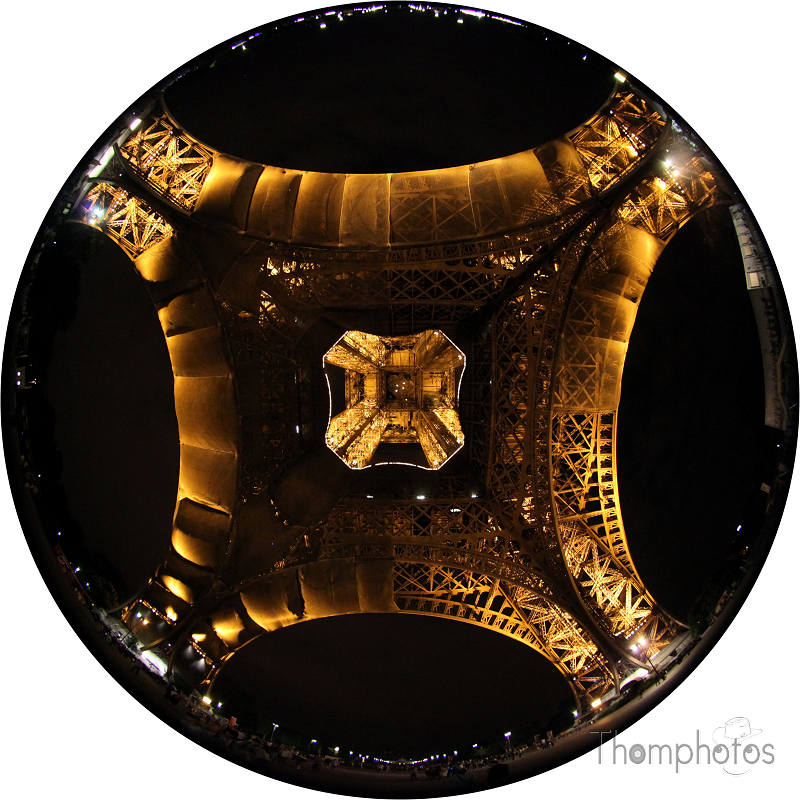J'ai eu cet objectif pendant environ un an il y a de ça plusieurs années (et puis il disparu, lors du
, volé avec la seconde sacoche). Mais j'en garde un bon souvenir (bien que très particulier d'utilisation). Pourquoi ne pas avoir fait le test avant ?
heu... bonne question. Pas de raison particulière, peut-être juste une préférence pour faire d'autres tests avant.
| Caractéristiques de l'objectif Sigma 8mm F3.5 EX DG Fisheye |
| Paramètres |
Valeurs |
| Type de monture |
Sigma de base, adapté au plein format (donc APS-C aussi) pour Canon et Nikon |
| Catégorie de l'objectif |
Focale fixe, Fisheye 180° |
| Focale |
8mm (équivalent capteur 24x36mm) |
| Ouverture |
Minimum F/3.5, maximum F/22 |
| Stabilisateur optique |
Non |
| Autofocus |
Oui, Mise au point Ultrasonique (HSM) |
| Distance minimale de mise au point |
13.5cm théoriques, mais 1.5cm en pratique |
| Traitements lentilles |
1 lentille SLD (Super-Low Dispersion) |
| Diaphragme |
6 lamelles |
| Diamètre filtre |
Filtres Gélatine à insertion (arrière de l'objectif) |
| Taille maxi |
Ø73.5mm x 68.6mm |
| Poids |
400g |
| Construction |
plastique avec revêtement polycarbonate, métal et Verre |
Que pourrait-on bien faire avec un objectif ayant un angle de vue à 180° et avec une déformation hémisphérique comme ça (le fameux effet Fisheye) ?
Déjà, pour des portraits en Close-up (très proche) afin de donner un effet sympathique et souvent marrant au visage (agrandissement du nez, bouche, oeil, et toute
partie située en plein centre de l'objectif). Comme ci-dessous par exemple (je m'étais prêté à l'expérience, lors d'une rando) :

Des portraits intéressants peuvent ainsi être réalisés, je n'ai malheureusement pas eu le temps de plus approfondire des idées de photos avec cet objectif. D'autres photos
sont aussi réalisables : avec des bâtiments (comme sous la tour-eiffel) :

Ou même des photos de paysages. De nuit, l'utilisation d'un fisheye peut donner de très bons résultats visuels, de même qu'en time-lapse ou vidéos. Dans un endroit exigüe, cet objectif
est tout simplement le plus approprié pour rendre toute l'ambiance sans avoir besoin de faire plusieurs photos et ensuite les coller ensembles, le rendu du fisheye donne une ambiance
très intime dans des endroits exigües. On est aussi bien plus proche du sujet.
La prise en main est assez facile, malgré les 180° d'angle de vue, on apprend rapidement à faire attention au cadrage et à éviter de voir ses propres pieds ou
des éléments indésirables sur les côtés. La construction est plutôt solide mais attention ! À cause de l'angle de 180°, la lentille frontale dépasse sur le devant (et peut donc se rayer
très facilement) et il n'y a pas de part-soleil (logique) donc la possibilité de flares est plutôt importante, même si les lentilles sont traitées. Le reste du corps est plutôt solide,
l'objectif se tient bien en main, la bague de mise au point est plutôt fluide, quoiqu'un peu fine. Et l'autofocus fonctionne très bien. En revanche, un petit soucis (mais je pense que celà
se retrouve sur tout les objectifs) : le bord de l'image délivrée par l'objectif a des franges chromatiques, qui peuvent être importantes dans certains cas où le contraste et la différence de luminosité est très
importante.
Comme on peut le voir sur la photo d'essai, l'image délivrée par l'objectif laisse des bords noirs, ceci est dû à la petitesse de la focale (et de pouvoir profiter de l'angle de 180°
en cercle). On laisse donc une bonne partie de la place sur le capteur inutilisée.
Certains logiciels permettent de ''dé-fisher'' la photo, passant d'une photo fisheye toute ronde avec un angle de 180° à une photos fisheye rectangulaire avec toujours l'angle de 180°.
Même si du coup, on perds une partie de l'effet, le rendu du fisheye rectangulaire est très intéressant aussi.
Au final, cet objectif peut être pas mal pour certains types de photos. Mais vu le prix (près de 1'000€ à l'époque), et le peu d'utilisation que j'en ai fais,
je pense que je ne le reprendrai pas. Je pensais l'utiliser plus souvent, mais il n'y a pas tant d'occasions que ça. En revanche, l'effet produit est vraiment très intéressant
et, au lieu d'en racheter un... pourquoi ne pas essayer d'en fabriquer un ? Peut-être un prochain article.
Pour quelqu'un qui compte utiliser beaucoup cet effet, (même pour filmer !), il peut être in bon investissement. Pour quelqu'un qui ne pense l'utiliser que rarement, il vaut mieux
se le faire prêter ou en fabriquer un soi-même (même si la qualité sera moindre), le prix de l'objectif n'étant pas négligeable.
Ce test, plutôt court, de l'objectif Sigma 8mm F3.5 EX DG Fisheye est maintenant terminé et j'espère qu'il vous aura été utile.


